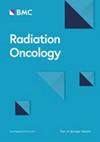Survival analysis after stereotactic ablative radiotherapy for early stage non-small cell lung cancer: a single-institution cohort study
IF 3.3
2区 医学
Q2 ONCOLOGY
引用次数: 0
Abstract
Stereotactic ablative radiotherapy (SABR) is the standard treatment for medically inoperable early-stage non-small cell lung cancer (ES-NSCLC), but which patients benefit from stereotactic radiotherapy is unclear. The aim of this study was to analyze prognostic factors for early mortality. From August 2010 to 2022, 617 patients with medically inoperable, peripheral or central ES-NSCLC were treated with SABR at our institution. We retrospectively evaluated the data from 172 consecutive patients treated from 2018 to 2020 to analyze the prognostic factors associated with overall survival (OS). The biological effective dose was > 100 Gy10 in all patients, and 60 Gy was applied in 3–5 fractions for a gross tumor volume (GTV) + 3 mm margin when the tumor diameter was < 1 cm; 30–33 Gy was delivered in one fraction. Real-time tumor tracking or an internal target volume approach was applied in 96% and 4% of cases, respectively. In uni- and multivariate analysis, a Cox model was used for the following variables: ventilation parameter FEV1, histology, age, T stage, central vs. peripheral site, gender, pretreatment PET, biologically effective dose (BED), and age-adjusted Charlson comorbidity index (AACCI). The median OS was 35.3 months. In univariate analysis, no correlation was found between OS and ventilation parameters, histology, PET, or centrality. Tumor diameter, biological effective dose, gender, and AACCI met the criteria for inclusion in the multivariate analysis. The multivariate model showed that males (HR 1.51, 95% CI 1.01–2.28; p = 0.05) and AACCI > 5 (HR 1.56, 95% CI 1.06–2.31; p = 0.026) were significant negative prognostic factors of OS. However, the analysis of OS showed that the significant effect of AACCI > 5 was achieved only after 3 years (3-year OS 37% vs. 56%, p = 0.021), whereas the OS in one year was similar (1-year OS 83% vs. 86%, p = 0.58). SABR of ES-NSCLC with precise image guidance is feasible for all medically inoperable patients with reasonable performance status. Early deaths were rare in our real-life cohort, and OS is clearly higher than would have been expected after best supportive care.早期非小细胞肺癌立体定向消融放疗后的生存率分析:一项单一机构队列研究
立体定向消融放疗(SABR)是治疗无法手术的早期非小细胞肺癌(ES-NSCLC)的标准疗法,但哪些患者能从立体定向放疗中获益尚不清楚。本研究旨在分析早期死亡率的预后因素。从2010年8月到2022年,我院共对617名无法手术、周围或中央型ES-NSCLC患者进行了立体定向放射治疗。我们回顾性评估了2018年至2020年接受治疗的172例连续患者的数据,分析了与总生存期(OS)相关的预后因素。所有患者的生物有效剂量均大于100 Gy10,当肿瘤直径为5时,肿瘤总体积(GTV)+3 mm边缘分3-5次应用60 Gy(HR 1.56,95% CI 1.06-2.31;P = 0.026)是OS的显著负性预后因素。然而,OS分析表明,AACCI>5的显著影响仅在3年后(3年OS为37% vs. 56%,p = 0.021),而1年的OS相似(1年OS为83% vs. 86%,p = 0.58)。在精确图像引导下对 ES-NSCLC 进行 SABR 是可行的,适用于所有医学上无法手术且表现状况良好的患者。在我们的实际队列中,早期死亡非常罕见,而OS明显高于最佳支持治疗后的预期。
本文章由计算机程序翻译,如有差异,请以英文原文为准。
求助全文
约1分钟内获得全文
求助全文
来源期刊

Radiation Oncology
ONCOLOGY-RADIOLOGY, NUCLEAR MEDICINE & MEDICAL IMAGING
CiteScore
6.50
自引率
2.80%
发文量
181
审稿时长
3-6 weeks
期刊介绍:
Radiation Oncology encompasses all aspects of research that impacts on the treatment of cancer using radiation. It publishes findings in molecular and cellular radiation biology, radiation physics, radiation technology, and clinical oncology.
文献相关原料
| 公司名称 | 产品信息 | 采购帮参考价格 |
|---|
 求助内容:
求助内容: 应助结果提醒方式:
应助结果提醒方式:


